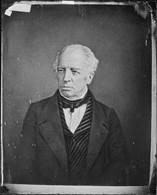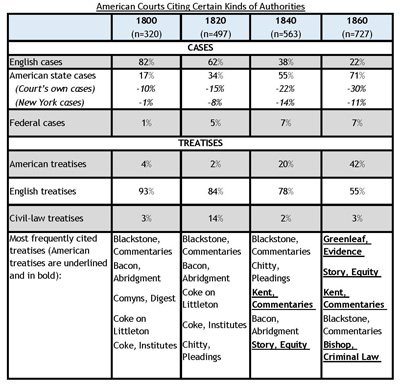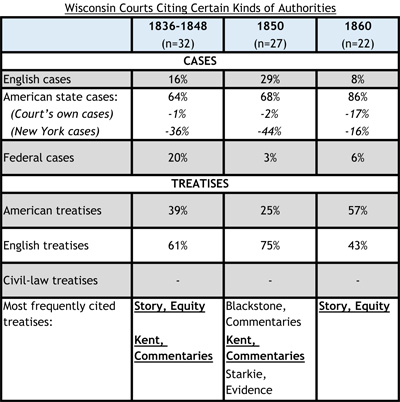
This is the third in a series of Schoone Fellowship Field Notes.
Legal cross-currents among states. Measuring the legal influence states have on each other is an intriguing but difficult task. Some scholars have approached the task by measuring the number of times a state’s supreme court decisions are cited in other states. Typically they have used these numbers to rank each state and have left it there. Little consideration has been given to regional variations in influence or changes in influence over time, or to the fact that judges rely on legal treatises as well as other courts’ decisions.
I have gone further, measuring case and treatise citations at 20-year intervals from 1800 to 1860. The book I am writing as part of the Schoone Fellowship will present these results in full. New York, as expected, was the most influential state but, surprisingly, American courts also relied heavily on English cases heavily until the 1840s. The numbers present a striking picture of America’s increasing reliance on its own law: (click on table to enlarge)
The pattern is also true for Wisconsin, which did not start reporting cases until the 1830s. American state court influence, and particularly that of New York courts, was on the rise, and reliance on English authority waned rapidly in both Wisconsin and the nation as a whole from 1835 to 1860 (click to enlarge):
Why was New York the most influential state? There are three main reasons: commerce, Kent, and publishing.
Commerce. About 1800, New York became the most populous state and New York City became the preeminent American port, and the completion of the Erie Canal in 1825 made New York the primary trading partner for much of the Midwest. A litigation boom accompanied the state’s commercial boom and made New York courts the cutting edge for advances in the law.
Chancellor Kent. James Kent ensured New York’s legal preeminence. He served on New York’s highest court (1800-15) and then as the state’s chancellor, the highest equity judge (1815-1823). Kent made the most of his opportunities to shape the law. For example, in Livingston v. Van Ingen (1812) he expanded the state’s control over river and maritime trade and guided the development of the steamboat industry so as to give New York important advantages over its neighboring states. In Methodist Episcopal Church v. Jaques (1815), he modified New York married women’s property rights in order to accommodate the needs of the new commercial system. Kent was also the father of the modern system of published case reports, and he used New York’s reports to disseminate his decisions nationwide. After retiring from the bench Kent wrote Commentaries on American Law (1826), the first American law treatise, which became an indispensable resource for judges and lawyers in Wisconsin and throughout America.
Publishing. New York’s leading legal publishers, most notably Banks & Gould of New York City and Albany, maintained an unmatched national network of booksellers that gave jurists in all corners of the nation access to New York judges’ decisions.
New York’s influence on Wisconsin. New York’s legal influence on Wisconsin was compounded by the fact that many early Wisconsin settlers came from New York and that many Wisconsin lawyers had obtained their training there before moving west. Wisconsin’s two constitutional conventions (1846, 1847-48) borrowed freely from New York’s recently enacted 1846 constitution, and the new state’s first major reform laws, the married women’s property rights of 1850 and the general banking law of 1852, also borrowed heavily New York experience. Wisconsin also followed New York’s codification movement, designed to simplify law and make it comprehensible and accessible to non-lawyers.
It is difficult to sum up the New York legal state of mind in simple terms. New York law balanced efforts to preserve English common law (led by Kent, a confirmed Anglophile) against the need to adapt that law to American commercial and social conditions (also heavily shaped by Kent) and impulses to move away from English law completely in some areas (for example, statutory codification and banking law). New York and its jurists strove to promote individual enterprise and liberty in order to enable the state and the nation to grow in power and prosperity. Early Wisconsin law strongly reflected that spirit.


